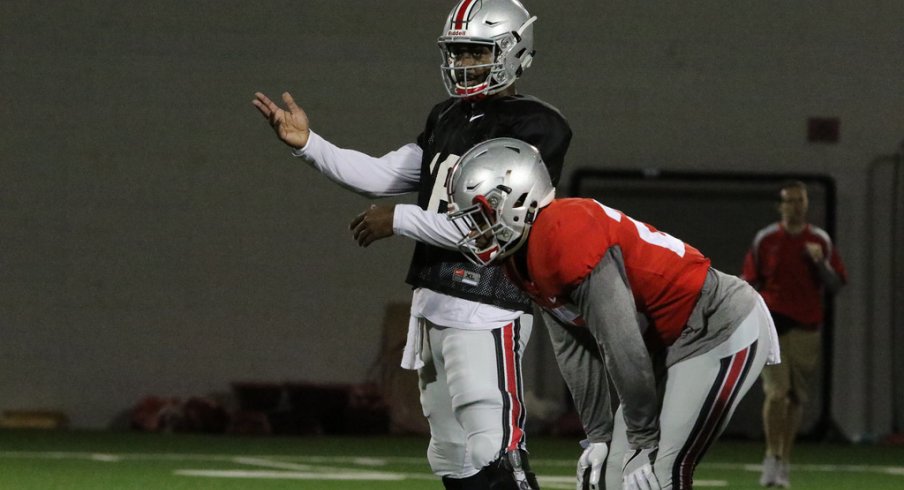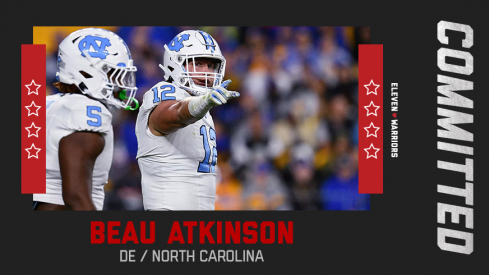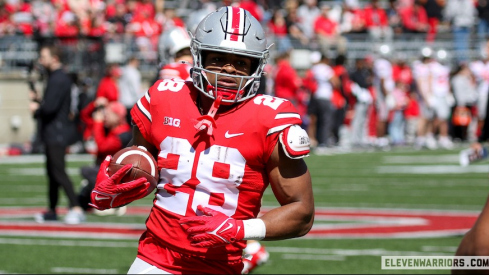This wasn't what we saw coming.
After a phenomenal breakout year in 2014, J.T. Barrett was supposed to be the next great Buckeye star, destined to lead Ohio State to consecutive championships before departing early with a high NFL draft grade. But ever since he emerged from relative anonymity in that initial campaign, Barrett seems to have regressed under the weight of expectations.
While Cardale Jones battled him for the starting job he eventually won in 2015, Barrett was supposed to take 'the leap' last fall, his fourth in Columbus. Yet despite leading the OSU offense to one of the best statistical seasons in school history, the junior QB and his unit failed to consistently move the ball against top-tier competition.
| Year | Yards/Play | Nat. Rank |
|---|---|---|
| 2012 | 6.06 | 33 |
| 2013 | 7.15 | 5 |
| 2014 | 6.98 | 6 |
| 2015 | 6.33 | 29 |
| 2016 | 6.02 | 47 |
Now entering his fifth and final season of eligibility in an OSU uniform, Barrett is working with the third offensive coordinator and position coach of his career. In place of Ed Warinner and Tim Beck stepped former Indiana head coach Kevin Wilson to run the offense and former San Francisco 49ers QB coach Ryan Day to coach the fifth-year senior, and both are tasked with getting the most of out of the Buckeyes' captain.
While much of the public focus has been on Barrett's ability to connect with receivers downfield, that's not the only place Wilson and Day have looked to easily manufacture yards for the QB. Though the Buckeyes must improve their intermediate and downfield passing on third down, another way to solve that problem is to avoid those situations entirely.
As long as Urban Meyer is in charge, the Ohio State offense will include a foundation of running the ball between the tackles - that's not up for debate. However, opponents in the Big Ten and nationally are also aware of this fact and will continue to cook up new defensive schemes to stop the Buckeye ground game every week. But instead of simply relying on the physicality of a veteran offensive line or the talents of future NFL running backs to pick up yards, Wilson and Day have added a few wrinkles to keep defenses back on their heels.
Though we've discussed the concept of Run-Pass Options here many times over the past few years, Wilson and Day have implemented an evolved philosophy on the subject. Instead of treating the addition of one pass route to a run play as a true RPO, those are simply 'reliefs' that can be added to any run concept as a 'tag' to the play-call, such as screens, hitches, outs, and slants.
This philosophy was on full display during the Spring Game last May, as all four Buckeye quarterbacks were asked to make simple decisions that took advantage of the field's full width.
For example, the 'split-zone' concept has been a central component of the OSU playbook since Meyer's arrival, bringing the tight end back across the formation from a 'Y-off' alignment to kick out the end and create a cutback lane for the back. As the alley defender (the SAM linebacker, in this case) cheats inside to give the defense a seventh player against only six blockers, the QB reads his alignment and decides to throw the bubble screen to the slot receiver, as only one defender is left to cover two players.
Again, this is a simple, snap decision made by the quarterback while everyone is standing still, not a complicated "if X, then Y' decision tree that must be taught on a true RPO. These concepts require far more drilling for the quarterback, as he's required to identify the actions of multiple players after the snap.
In Wilson and Day's offense, a real Run-Pass Option combines a run with a passing concept that includes multiple receivers, such as a slant-flat combo that asks the QB to identify and read the flat defender midway through the play.
While the Buckeyes will undoubtedly include multiple RPOs in each week's game plan this fall, they're also going to get creative with the way they package their reliefs. One such way is to create a veritable 'triple option' concept by including a short route to the flat, such as a bubble screen or arrow route, which takes the place of a pitch outside.
And while these reliefs will take the pressure off Barrett to pick up yards with his legs in the option game, he's still a dangerous weapon as a runner and Wilson will have no problem using him as such. Whenever there is a way to remove a defender from the play when he takes off, though, Wilson and Day will look to do so.
In the example below, we see the Buckeyes in an empty formation with the tight end lined up off the line as a wing. To the defense, this appears to be a clear passing formation. However, once the unblocked end recognizes the run blocking in front of him, he properly steps down to take away the run gap. So, Barrett correctly decides to make an easy throw to his slot receiver on a bubble screen instead of keeping to run for himself.
But you're probably wondering why I'm showing examples that rarely resulted in big gains. These reliefs aren't necessarily there to create space on that very play, but to create constant conflict for the defense. If the Buckeyes constantly show the threat of attacking the edges while blocking a run play, defenders must stay honest and honor that risk.
After only 15 minutes of action in the spring game, opposing defenders began playing with hesitation after seeing a multitude of reliefs coming their way. As you can see below, the Buckeyes are running their basic tight-zone option away from the three receiver side, leaving the end unblocked and keeping the QB from ever even looking at the bubble screen. However, as the safety to that side sees the bubble action added to the play as a decoy, he hesitates and slows down instead of crashing downfield in run support.
Creating this kind of conflict in the mind of defenders has been a missing ingredient in the Buckeye offense over the past two seasons. While lesser opponents may have recognized exactly what was coming their way, they were often powerless to stop it, given the physical superiority that Ohio State brings to most contests.
But against the Penn States, Michigans, and Clemsons of the world, the Buckeyes are foolish to believe they can simply out-talent or out-execute the competition. Additionally, after an oft-maligned wide receiver lost its top three contributors from last year, the easiest way to incorporate Parris Campbell, K.J. Hill, and Terry McLaurin into the passing game is to get them the ball in space on easy routes like these.
Though these simple tweaks may seem insignificant, their value will be measured by the offense's total sum. By adding reliefs to their base run game, the Buckeye offense will become more efficient on early downs, making those third-and-longs far more infrequent - and making J.T. Barrett's final season in scarlet and gray a whole lot more enjoyable.



